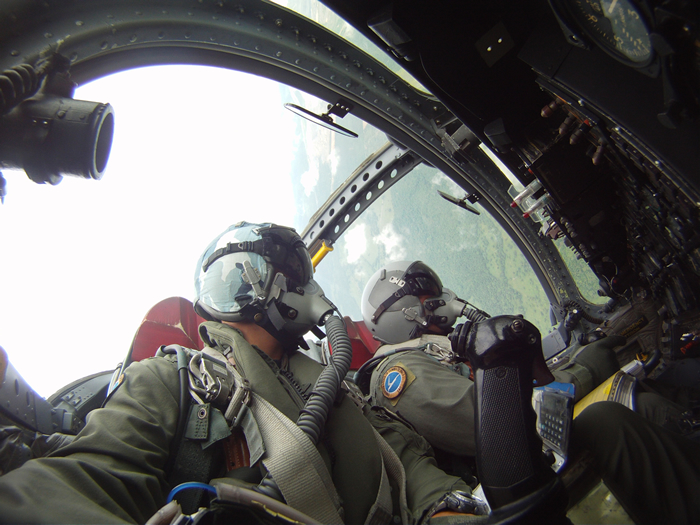Defense systems concerning the construction of public affairs for a complex society, practically chaotic.
DOI:
https://doi.org/10.18667/cienciaypoderaereo.530Keywords:
Construction of Public Affairs, Defense Systems, State, WarAbstract
War, understood as the bellicose manifestation of social and political conflicts, is a constant in human history. However, it is not possible to ensure that its representations have also been constant. For this reason, it is imperative that any society establishes defense systems to protect itself, starting from the idea that these are used to neutralize through deterrence of threats. Nowadays, when transnational or asymmetric non-state threats are considered, the armed forces are not enough as a sole power resource within a defense system. Therefore, one must appropriate the notion that before a changing world, a good defense system must commit civil society to its correct implementation.
Downloads
References
Aron, R. (1966). Peace and war. Cambridge: Cambridge Univ Press.
Arquilla, J., & Ronfeldt, D. (2000). Swarming and the Future of Conflict. Santa Monica, CA: RAND Corporation.
Bousquet, A. (2009). The scientific way of warfare: Order and chaos on the battlefields of modernity. New York: Columbia University Press.
Carr, J. (2011). Inside Cyber Warfare: Mapping the cyber underworld. Sebastopol, CA: O'Reilly Media, Inc.
Dougherty, J. E., & Pfaltzgraff, R. L. (1990). Contending Theories of International Realtions: A Comprehensive Survey. New York: Harper & Row Publishers.
Galula, D. (1964). Counterinsurgency Warfare: Theory and Practice. Westport, CN: Praeger Security International.
Gray, C. S. (2013). Making strategic sense of cyber power: why the sky is not falling. Carlisle, PA: DTIC Document.
https://doi.org/10.21236/ADA584060
Hall, W. M., & Citrenbaum, G. (2009). Intelligence Analysis: How to Think in Complex Environments: How to Think in Complex Environments. Santa Barbara, CA: ABC-CLIO.
Hanson, V. D. (2010). Guerra: El origen de todo. Madrid: Turner Noema.
Keefe, P. R. (2013). The Geography of Badness: Mapping the Hubs of the Illicit Global Economy. En M. Miklaucic & J. Brewer (Eds.), Convergence: Illicit Networks and National Security in the Age of Globalization (pp. 97-110). Washington, D.C.: National Defense University Press.
Keegan, J. (2004). Historia de la Guerra. Madrid: Turner Noema.
Kissane, D. (2011). Beyond Anarchy: The Complex and Chaotic Dynamics of International Politics
Lind, W. S., Nightengale, K., Schmitt, J. F., Sutton, J. W., & Wilson, G. I. (1989). The Changing Face of War: Into the Fourth Generation. Marine Corps Gazette, 73(10), 22-26.
Luke, T. W. (2004). Everyday Technics as Extraordinary Threats: Urban Technostructures and Non-Places in Terrorist Actions. En S. Graham (Ed.), Cities, War and Terrorism: Towards an Urban Geopolitics (pp. 120-136). Malden, MA: Blackwell Publishing.
https://doi.org/10.1002/9780470753033.ch7
Miklaucic, M., & Naím, M. (2013). The Criminal State. En M. Miklaucic & J. Brewer (Eds.), Convergence: Illicit Networks and National Security in the Age of Globalization (pp. 149-170). Washington, D.C.: National Defense University Press.
https://doi.org/10.21236/ADA590461
Norwood, K. T., & Catwell, S. P. (2009). Cybersecurity, Cyberanalysis and Warning. New York, NY: Nova Science Publishers, Inc.
Rosenau, J. N. (1990). Turbulence in world politics: A theory of change and continuity. Princeton, NJ: Princeton University Press.
https://doi.org/10.1515/9780691188522
Serra, E. (2013). Introducción. Cuadernos de Estrategia: Los Potenciadores de Riesgo, 1(159), 10-26.
Singer, P. W., & Friedman, A. (2014). Cybersecurity and Cyberwar: What everybody needs to know. New York: Oxford University Press.
Thauby, F. (1999). Disuasión y Defensa. Revista Marina, 1(2), 1-17.

Downloads
Published
Issue
Section
License
Assignment of Copyrights
Authors assign Ciencia y Poder Aéreo journal the exclusive rights (reproduction, distribution, public communication, and transformation) to exploit and commercialize their work, in whole or in part, in all the formats and modalities of present or future exploitation, in all languages, throughout the life of the work and throughout the world.
All contents published in Ciencia y Poder Aéreo journal are licensed under a Creative Commons Attribution 4.0 International License, whose complete information is available at http://creativecommons.org/licenses/by/4.0/
Under the terms of this license, users are free to download, print, extract, archive, distribute and publicly communicate the content of articles, provided that proper credit is granted to authors and Ciencia y Poder Aéreo, scientific journal of the Graduate School of the Colombian Air Force. Except when otherwise indicated, this site and its contents are licensed under a Creative Commons Attribution 4.0 International License.
For other uses not considered under this license it is required to contact the Director or the Editor of the journal at the e-mail address cienciaypoderaereo1@gmail.com.
The Graduate School of the Colombian Air Force and this publication are not responsible for the concepts expressed in the articles, including the metadata or the affiliation stated by authors. This is the full responsibility of the authors.





















